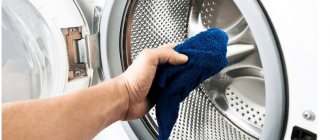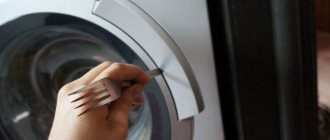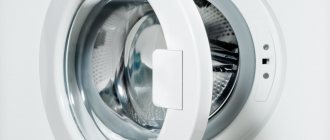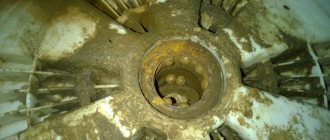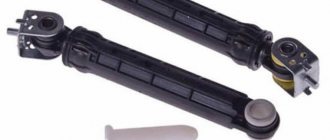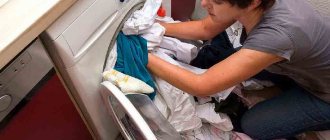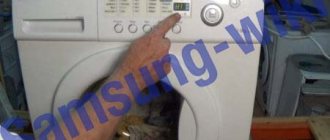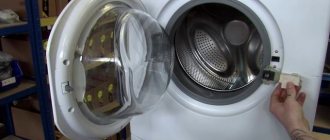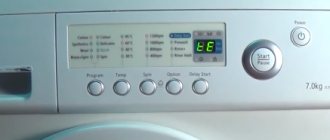A sudden stop of the washing machine drum can be caused by several reasons, but most often this “behavior” of a household appliance occurs if the rotating part has flown off its mounting position. Such a breakdown is mechanical, so self-repair requires virtually no knowledge in the field of circuitry. This article will discuss the main causes of such a breakdown, as well as the simplest ways to repair a household appliance yourself if the drum in the washing machine has fallen off.
Diagnosis of failure
Before you begin self-repair, you should carry out the following diagnostic steps:
- Open the door of the household appliance and rock the drum back and forth; if there is significant play in the fastening of this part, then the bearings are most likely faulty. This type of malfunction is also indicated by the presence of a hum and grinding noise when turning the internal parts of the machine.
- If, after carrying out the above-described manipulations, it was not possible to accurately determine the serviceability of the elements of the rotating parts of the washing machine, then you need to turn on the device in spin mode at maximum speed. If there is a distinct hum and beating, you can diagnose excessive wear of the bearings, as well as possible problems in the performance of the shock absorbers.
- Drive belt malfunctions can manifest themselves primarily as insufficient rotation of the drum under load. This breakdown also often results in this type of breakdown.
If, as a result of the above-described manipulations, one of the drum breakdowns was diagnosed, then to eliminate it you will need to disassemble the household appliance.
Other reasons
Below is a list of less common breakdowns that affect the operation of the washing machine drum. It should be noted that this list is far from complete, since each model has its own characteristics.
- Failure of the heating element.
Very rarely, a tubular heating element overheats, bursts and falls apart. Its fragments can cause the drum to block. - Capacitor failure.
If you have an older model washing machine, then the drum has probably stopped rotating because the capacitor has failed. Fortunately, the capacitor is a part that is fairly easy to replace. - Pump malfunction.
If the pump does not fill or release water, the drum may automatically block.
Debugg
To access the damaged part of the washing machine, you will need to partially disassemble the household appliance. The best way to access the inside of a household appliance is to remove the back cover.
This option is ideal for disassembling LG or Ariston Hotpoint machines. On some Samsung, Indesit and Bosch models, in order to get to the internal parts, you will first need to remove the top cover of the household appliance. Before you begin disassembling the washing machine, you should remove the power plug from the socket and also turn off the water supply to the device.
The top or back covers are secured with screws that can be easily removed with a screwdriver. After access to the internal parts of the machine is opened, depending on the cause of the malfunction, a certain sequence of actions is performed.
Replacing bearings
If the reason that the drum has come off the shaft is a faulty bearing, then repairing the household appliance is only possible by replacing these parts. The operation is performed in the following sequence:
- The top and bottom weights are removed. As a rule, in order to remove these parts, it is enough to unscrew 4 bolts.
- Carefully remove the drive belt from the pulley.
- The heating element is removed from the tank.
- The plastic clamps of the shock absorbers are removed.
- The springs are released.
- The electric motor is dismantled.
- The pulley is removed from the rotating part.
Now you will have access to the bearing, which should be removed using a special puller. What to do if there is no such tool? In this case, you can use a hammer and any oblong object of small diameter to knock the product out of its seat. When removing a bearing in this way, care should be taken, as careless actions can lead to damage to the rotating part of the household appliance.
When the old bearing is removed, a new part is pressed into its place, after which the car is reassembled in the reverse order.
Shock absorber repair
If the drum falls off due to a faulty shock absorber, then this part can also be easily repaired on your own. When the rear cover is removed, you should find the mounts on the rotating part of the machine to which the shock absorbers are attached. On many models there are at least four such elements, so you should inspect each one for damage.
Sometimes the spring can simply fly off the mount, so to restore the functionality of the device, it is enough to install the shock-absorbing element in place. If the spring breaks, it should be replaced with an original product.
Some models of washing machines use dampers as shock absorbers. If such a part is damaged, you will need to purchase a new product or remove it from a faulty “donor” of the same model.
Replacing the drive belt
Sometimes the reason for the drum moving out of its seat may be a heavily worn drive belt. In this case, you cannot do without replacing this part. This is quite easy to do, because each product has markings, which will make it easy to choose a new belt.
The belt is first put on the electric motor pulley, and then installed on a larger diameter wheel located on the tank. To make the task easier, you can pry the belt with a screwdriver, but even a new, undeveloped belt is usually easy to put on by turning the pulley 1 turn, after first throwing the part onto the wheel.
If the drum in the washing machine falls off, then it is absolutely not necessary to seek help from specialized workshops. You can save a lot if you carry out the repairs yourself according to the recommendations given in this article.
We determine the cause of the malfunction and eliminate it
What to do first? Having noticed that the drum is skewed, you will have to “cut off” one possible cause of the malfunction after another. It is recommended to carry out the check from simple to more complex. First you should inspect the drive belt. For this:
- unplug the power cord of the machine from the outlet;
- remove the back wall of the case by unscrewing all the screws securing it (for some washing machine models you will first have to remove the top cover);
- assess the condition of the belt.
Ideally, it should be tightly stretched between the drum and the motor. If the belt comes off, put it back in place. If you find that the elastic band is torn, purchase a new strap. When purchasing components, be sure to look at the model and serial number of the washing machine.
Having found out that everything is in order with the drive belt, proceed to check the shock-absorbing system. If the tank falls into the housing, most likely the reason for this is broken springs. During washing and spinning, it is the metal spirals that hold the tank, preventing it from falling off.
If at least one shock-absorbing spring breaks, the drum will move and the operation of the washing machine will be disrupted.
Typically, the tank is held in place by two springs: lower and upper. There should be no problems with dismantling the parts. You must first unhook the tip of the “spiral” from the tank, and only then from the body. A new shock-absorbing element is also installed.
It may not be the spring, but a broken damper. To dismantle the element, you will need to remove the front wall of the housing. The algorithm of actions will be as follows:
- remove the top housing cover;
- remove the lower false panel, behind which the garbage filter is hidden;
- remove the powder receptacle from the machine;
- Unscrew the screws holding the control panel;
- Carefully, so as not to damage the wiring, place the “tidy” on the washing machine;
- unscrew the bolts securing the front wall and unhook it from the body.
This way you can get free access to the dampers. Their lower part is attached to the body with a bolt, the opposite part is connected to the tank using latches. Unscrew the screw and deal with the latches. Then remove the damaged damping element.
Next, you need to install new shock absorbers in their original place. It is important to secure the dampers well so that in the future the drum does not come off during the spin process. The shock-absorbing elements will begin to support the tank again, and the distortion will be dealt with.
Incorrect installation
The drum in the washing machine knocks during the spin cycle due to non-compliance with operating instructions. Often the owners, after installing the unit, are in a hurry and do not level it, and also forget to remove the shipping bolts. It is at high speeds that this becomes apparent. And the task of the bolts is to hold the drum back, so an unusual sound will be heard.
Installation must take place on a solid base; some cast it from concrete. In addition, it is worth adjusting the legs. This is true in cases where the floor surface is already finished with tiles or something else. So in such a situation, it is worth correcting the situation, and the operation of the machine will return to normal. To check whether everything is done correctly, you need to try to rock the device with your hands. If there is no movement, everything is done correctly. The machine should not shake.
How to fix a fallen drum
There are several ways to replace a fallen drum, depending on the type of damage. You need to start with the simplest.
Checking the drive belt
- Disconnect the machine from power.
- After unscrewing all the screws around the perimeter, remove the back panel and check the condition of the belt.
- If it comes off, put it on the motor shaft first, then on the drum pulley.
- To make installation easier, rotate the pulley by hand when putting on the belt.
- If the belt is broken, replace it with a new one. Each product has a serial number, which can be used to select a similar model.
If after checking it turns out that the belt is in order, continue the diagnosis.
Springs and dampers
If the tank falls and falls into the housing, the reason is a malfunction of the springs that secure the tank with the drum on top. During spinning and strong rotations, the springs keep the tank from jumping off. If one of the springs suddenly bursts, a replacement is needed.
How to replace washing machine shock absorbers
Most modern models have specific shock absorbers - dampers. Finding repair kits or spare parts for them is almost impossible, so the worn-out part is replaced with a new one, and they are replaced in pairs. To manipulate dampers you need:
- Flathead and Phillips screwdrivers
Set of open-end wrenches
Components suitable for the washing machine being repaired
In most devices used, to get to the shock absorbers, it is enough to remove the front panel by unscrewing the screws that secure it, removing the powder tray, disconnecting the control panel and door lock wires. Remove the damaged dampers and reassemble the machine. What to do if difficulties arise during the disassembly (assembly) process? It’s better not to take risks and call a specialist, because we are talking not just about wiring, but about the “brains” of the machine, damage to which can greatly increase the cost of repairs.
A foreign object is rattling in the washing machine
Often the causes of strange sounds in the car are foreign bodies caught in the drum. Owners often forget small change, keys and other small metal items in the pockets of clothes being washed. Buttons and rhinestones that flew off during the spin cycle, bra underwire - there are a lot of culprits for knocking in the tank.
The main danger of foreign objects getting into the tank is the risk of jamming the device and causing holes. After removing unnecessary objects, it is worthwhile to diagnose other components of the machine that could also be damaged during operation of the device.
Preparation for repair
Replacing a washing machine tub is not an easy job, so it requires careful preparation. First you need to prepare the tools:
- set of screwdrivers: slotted, Phillips, hex;
- socket and wrenches;
- wire cutters;
- pliers;
- WD-40.
Before you begin repairing your washing machine, you need to prepare it, namely:
- Turn off power.
- Disconnect the intake hose and drain all water.
- Drain the water from the drain filter.
- Move the washing machine away from the walls.
Of course, you need to purchase the required tank model. The most convenient way to do this is through our online store.
Useful arguments from experts
In the professional work of washing machine repairmen, questions often arise to which they do not always know the answers. Because the reasons can be common and unexpected, depending on the model of the unit. Therefore, you need to know what to do if the washing machine drum is knocking. The division is based on models characteristic of their work:
- “Veko” - this model is known to many. What does it mean if the drum starts making a knocking noise during the spin cycle? To fix the problem, you need to replace the bearings, but at the same time install new seals. You can also look at the cross shaft.
- "Atlant". Increased knocking and vibration may occur during operation. The problem is eliminated when the unit is installed level and according to the instructions.
- "Ariston". Complaints about knocking and vibration. After replacing the seals and bearings, the problem did not go away. As a result, it was necessary to change the shaft.
- "Samsung". After a long period of operation, vibrations began and a grinding noise appeared. After another job, a heap of substance comparable to cement and dust fell out from below. This is a breakdown of the heating element. In addition, such processes can lead to failure of the motor itself.
- LG often suffers from squeaking. This happens when any small particles get caught between the drum and the side of the machine.
Some models have their own breakdowns. But this is optional. They also have a shelf life without repair (again, this is all on an individual basis). The only point that applies to each model is that if any knocking or grinding noise occurs, you cannot end the cycle and not pay attention to it. Otherwise, you will have to invest a lot of money on repairs.
Why does the drum in the washing machine wobble?
A slight play in the drum is not a breakdown. This work is provided by the manufacturer. If it begins to wobble more than before, then this indicates a problem.
You can diagnose the problem yourself, but we recommend contacting a professional. In this case, you only win:
- If this is a breakdown, our technician will fix it immediately
- If this is NOT a breakdown, then additional diagnostics and cleaning of the washing machine will not harm.
If you want to diagnose the problem yourself, then stock up on tools, patience and our algorithm:
- Open the hatch cover of the washing machine, grab the drum and move it in different directions, twist it. If you hear knocking or grinding, then there is a breakdown. If, when manually turning the drum, you feel that it is moving hard, then there is a high probability of bearing failure.
- Turn on the machine and set the spin program to maximum speed (1000-1400 rpm). If it is noticeable that the drum seems to have flown off the axle, then either the bearing has failed or the shock absorber has failed.
- Stop the car and look under it. If there is a problem with the bearing, then most likely there will be a puddle under the washer (since water seeps through the moving element on the back wall of the tank). Read more here: .
- If there is a knocking sound, but there is no water, then the shock absorbers are probably broken. It is important to understand that if one shock absorber breaks, then all of them must be replaced.
Without disassembling the washing machine, nothing more can be found out.
A loose drum is a clear reason to take any measures to eliminate the malfunction, since breakdowns associated with this can subsequently damage other components of the device. But do not rush to contact the service center, first try to detect faults. You may be able to fix them yourself. We recommend that you study our reviews, in which we looked at the error codes of the self-diagnosis system of washing machines, in order to quickly identify and eliminate some faults in a timely manner, for example, “Hans washing machine codes” or “Whirlpool washing machine codes”.
If you are not at all versed in technology, then it is better not to try to disassemble the washing machine. Such actions can only worsen the problem, and repairs will cost much more.
When the drum of the washing machine is loose, most often the washing machine hums during the spin cycle and vibrates strongly. You can feel the “chatter” by moving the drum to the sides
.
There are two reasons for this malfunction:
- The bearing has worn out or fallen apart.
- The shock absorbers "died".
How to determine what has gone wrong? Very simple.
Bearing problem
To determine this malfunction, it is enough to move the drum in different directions with your hands. Play (strong or weak) indicates bearing wear. Typically this problem is accompanied by a strong hum and slight vibration.
A bearing is a durable part, but still has a limited service life. This element fails due to two reasons: wear or water getting into it. The latter causes corrosion of metal parts, which in the shortest possible time makes the metal non-working. Often the bearing life is 7-10 years.
If you find such a problem, then do not delay, but replace all bearings as quickly as possible or take the device to a workshop
. It is not recommended to use faulty equipment.
Shock absorbers are broken
To identify this problem, you will also need to dig around in the machine with your hands, but do not move the drum, but slightly pull it towards you and release it. If it does not fall into place, but begins to wobble/lobble, then this is a clear sign of failure of the dampers/shock absorbers.
Shock absorbers serve to soften vibrations during spinning. If even one element breaks, strong vibrations occur and noise may occur. The washing machine has two dampers and two springs. They must be changed in pairs.
Breakage of shock absorbers leads to increased wear of all associated components in the device, including the bearing. Therefore, it is recommended to immediately fix the problem at home or contact a service center.
What to do when the drum jams
For repairs, you don’t need much: an instruction manual, self-diagnosis to find out the causes of the breakdown, patience and several tools that can be found in the case of any home craftsman.
Replace brushes
If the reason is wear on the electric motor brushes, causing the drum to rotate slowly or slow down, you need to replace these elements. The repair consists of disassembling the SMA housing, removing the motor and installing brushes. The whole process is described in detail in the article “How to replace motor brushes” - there you will find step-by-step instructions with photos and videos.
For owners of Bosch washing machines, we have a separate instruction “How to replace brushes on a Bosch washing machine.”
Replace heating element
If the drum is jammed and the washing does not start at all, the problem is in the heater: you need to remove and replace the heating element. It could simply burn out, short out, or even explode.
In each brand, the heating element is removed in its own way: from the front or from the back. For example, in SM Bosch, Siemens and AEG, the heater is replaced exclusively from the front panel. And in other common models (Whirlpool, Ardo, Zanussi), to replace the heating element, just unscrew the back panel.
Replacing this part does not require any special repair skills, and your main task is to purchase an original analogue that matches your brand and model of washer. You will learn more about checking and replacing this element from the articles: “How to check the heating element” and “How to replace the heating element”.
We also have separate replacement instructions for owners of Indesit, Samsung, Bosch and LG washing machines.
Remove foreign object
If you notice that the drum rotates heavily or jerkily, sometimes sticks and jams, and is also accompanied by a knocking sound from the housing, it is quite possible that the problem is an object stuck between the walls of the tank and the drum.
To check this, in most models it is enough to unscrew the back wall and remove the heating element (at the same time you can check it or clean it from scale). If it is difficult to see the object, shine a flashlight into the hole in which the heating element was located.
On a note! Typically, the cause of drum jamming is bra underwire. Buy a special case for washing such laundry.
Check control module
If the drum rotates slowly during washing, the control module may be damaged. In this case, firmware or replacement of the electronic unit is needed.
If you do not feel like an expert in this industry, entrust the repair to a good master. If you are confident in your abilities, look for instructions in the article “Do-it-yourself repair of the control board of a washing machine.”
How to remove the drum
There are many brands of washing devices. The most famous are: LG, Samsung, Whirlpool, Indesit, Zanussi, Bosch, Kaiser. Each of them has design features, but the main elements, as well as their location, are almost the same. For this reason, the procedure for disassembling will be approximately the same.
Removing fasteners
Removing the drum, as well as other repair work on the unit, begins from the top panel. As a rule, the bolts for fastening the latter are located on the rear side. But it happens that they are found on the sides.
The back panel is removed after unscrewing the screws that hold it in place. To separate the drive belt, you need to carefully rotate the pulley wheel in a clockwise direction.
The dashboard is secured with screws located in the niche of the detergent tray.
Before dismantling the front cover, the hatch door is removed and the rubber cuff is disconnected. Then, after unscrewing several fixing screws, the front panel is carefully removed.
Removing parts
To release the upper part of the tank, it is necessary to remove the pipe, counterweight, water intake valve, and pressure switch.
In the lower part, the heating element, engine, drain pipe, lower counterweight, and shock absorbers are removed. In most devices, the heating element is located under the tank. To remove it, the contacts are disconnected and the nut, which has a central location, is unscrewed.
Unscrewing the “stones” is done very carefully so as not to accidentally drop them on the body of the washing machine or on your feet.
To remove the electric motor, you need to remove the power plug and grounding wire from it, and only then unscrew the mounting bolts (usually four). To remove the drain pipe and shock absorbers, place the machine on its side. Using pliers, the clamp is removed and the pipe is disconnected from the pump. Only then are the shock absorber mounts unscrewed and the tank freed from the hooks. To dismantle the pipe, the clamps that hold it are loosened and removed.
After completing all the procedures described above, the tank can be removed from the body of the washing unit.
Removing the tank alone will not be easy. It is best to perform this procedure with a partner. One person must neutralize the springs, and the other must remove the tank. In addition, you should be very careful, since the part is heavy and easy to drop.
Pulling out the drum
It is possible to remove the drum from the “remains” of the tank only after unscrewing it (with a wrench) and removing the pulley. Then return the bolt that held the pulley to its original position (all the way). Finally, using a hammer to lightly tap the shaft, tap the drum out of the tank.
If the washing device is to be reassembled, it is recommended to carefully check the integrity of the bearings and replace them if necessary. It is imperative to install a new oil seal and treat it with lubricant.
When thoroughly disassembling the washing machine, you need to check all its parts for functionality. An ordinary tester will help assess the condition of all electronics. A visual inspection will also be helpful. You should definitely take a closer look at the heating element: if there is scale, it is recommended to clean or replace it.
We repair the washing machine ourselves
We will provide a detailed algorithm that will allow you to disassemble the washing machine without outside help and carry out the necessary repairs.
- Unscrew the two screws on the back of the cover. Slide it forward and lift it up. Now it can be removed to the side.
- There are screws around the perimeter of the back cover. They need to be unscrewed and the back cover removed. It can also be removed to the side.
- Let's move on to the detergent dispenser tray. Press the latch in the center, unscrew the connecting screws, and remove the clamps using a flat-head screwdriver. Place it on the top of the structure without unfastening the wires.
- Next we work with the hatch. Open the door and bend the seal, pull out the clamp. The cuff must be inserted into the drum.
- Unscrew the screws on the front panel and remove it. Can be put aside.
- Next, we remove unnecessary parts from the front part: counterweights from the tank, heating element wiring and drain pipe. This is quite easy to do.
- We also do the same with the elements of the front and rear parts: the pipe leading from the tank to the hopper, the hopper along with the outlet valve, the counterweight, the pressure switch hose, the drive belt from the pulley (inspect its integrity), the pulley itself, the motor and the wiring around the perimeter of the tank.
So, we have come to the most crucial moment - dismantling the tank. To do this, unscrew the shock absorber bolts and remove the tank from the springs. The old tank has been dismantled.
Attach the pulley to the new tank (you may need help here) and secure it with a bolt. Hang the tank with the drum on the hooks, passing it through the top of the body. Next, you can assemble the washing machine in the reverse order of the algorithm described above. Upon completion of work, check the system status - everything should work again.
What's wrong with the underwear?
Often the washing machine drum knocks when rotating. This is typical for older models. This especially begins to happen when the laundry is collected in one lump (imbalance). Because the cylinder begins to knock in one direction and this gives strange sounds, grinding, etc. But not every cycle will be done this way. There are obvious situations:
- Lots of small things.
- Bed sheets.
- Loading weights that are not permitted according to the instructions.
To eliminate the knocking, the cycle is stopped, the drum is opened and things are laid out or unnecessary items are removed. To prevent this from happening in the future, you should adhere to the operating rules and load small laundry halfway with large laundry. Today, manufacturers take this error into account and create new models of the unit with a stacking control system. Therefore, when purchasing, you can already get rid of the occurrence of such a problem in the future.
In addition, laundry can be the simplest reason why the drum in the washing machine knocks when washing. Namely, items left in pockets, as well as buttons, straps and fasteners. They are capable of breaking away and getting into any gaps. And children in the family can do interesting things by stuffing small things into the drum or powder tray itself. This is a serious issue because such items get into the drum and it breaks down. If you manually spin the drum, it is easy to understand that there is something inside.
You can remove these elements yourself, using a small wire, placing it in the cracks. But the simplest method is removal through the installation holes of the heater (heater). It is worth doing some minor disassembly and only then removing the items. When everything is returned to its place, you need to install a new seal and lubricate it.
Vertical and frontal models
A wide variety of washing machine models are available to the user. In addition to the unique professional line, which can even be used on marine vessels, you can choose more convenient home models with vertical or front loading. The company's engineers have taken care of both connoisseurs of compact washing machines and those who prefer more comfortable work with a wide side hatch. Top-loading models take up less space and can be installed even in small spaces, while front-loading models reduce water consumption and make loading laundry more convenient. Both types of machines are made of premium materials and equipped with many useful programs that will allow you to get the cleanest laundry possible over and over again.
Drum pulley
If nuts or bolts become loose over time, vibration occurs. When a part is restored, the attachment point is additionally sealed with sealant.
These are the simplest breakdowns. The rest lead to expensive repairs, although some purchase a new machine. Because to restore functionality, the technician has to disassemble the entire machine. To answer the question why the drum is knocking in the washing machine, you need to work through each option.
Reasons for drum displacement
If you think the drum is warped, immediately perform a quick diagnostic test on your washing machine. Turn off the power to the “home assistant” and start checking. What to do in such a situation?
During diagnostics, be sure to inspect the rear of the tank. If rusty stains or signs of wear are visible on the plastic, then “problems” with the drum are caused by broken bearings and a leaky oil seal.
In general, drum misalignment is most often noted for the following reasons:
If you think that the drum has come off, it is better not to risk it and do not use the washing machine. You can perform equipment diagnostics yourself. We’ll tell you where to start checking and how to get your “home assistant” back on track.
